The Origin and meaning of the Surname of Hope
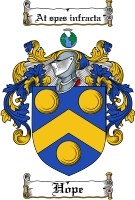
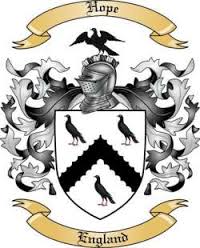

Scotland England & Wales Ireland
(NOTE - The following research was carried out around the time of the millenium and since that time Ancestral DNA technology has advanced considerably. The concept of the Scottish Hopes being two distinct families - Border Hopes and Edinburgh Hopes is perhaps not so quite clear cut as indicated below as evidences by modern DNA and that there was some infusion albeit probably before 1100 when surnames first came in. However the concept of multiple origins of the surname of Hope still holds water. Ed. 2018)
The conventional wisdom on the origin of the surname of Hope is that it is derived, certainly in the UK, from the name of a topographical feature - a small enclosed valley. However there are many variations of this feature - see entry in the Oxford English Dictionary below - also note that the valley definition is only the second one on the OED List.
What follows is a fairly lengthy, but interesting, preamble before you come to a Contents List. This list divides the research into manageable geographically oriented sections including sections on the Hope Tartan, Hope Heraldry, Craighall/Granton Castles, etc- to get to this List now go to :-
Contents List page.
The requirement for surnames came about 1100 AD. At that time people living in, or close to a hope, would take Hope or if the hope was named such as Hopkirk, Hopringle take that as their surname. Others would take the name of other topographical features such as Hill, Marsh, Craig (Cragg), etc. Some would take the names of landscape features such as Field, Forrest, Meadows etc. Others would take their profession such as Farmer, Forrester, Baker etc. Others took the name of their locality, known as a habitational names, such as the people that took a named hope as their surname. People with habitational names tend to have the same DNA. However, folks with the plain Hope surname will have multiple DNA as indicated in the following study.
The surname of Hope had various spellings - the following from the Scottish records - Hop, Houppe, Houp, Hoip, Hoppe and Hopes. Hopes and Hoppe still survive as separate surnames.
However, there is a lot more to a hope than a mere topographical feature as the following study has revealed an astonishing array of variations, overlays and sub stratas. This - along with other issues - leads to the conclusion that there is no single origin of the surname and that it has multiple origins spread over the UK, Ireland, and also Northern Europe and Scandinavia.
The word hope for a topographical feature would appear to have been a very useful word and the reason for its disappearance from present day English is not known. The word however does cling on in the Scottish Borders area.
The four main layers of the following study into the origins of the surname are as follows.
1. General investigation into the word hope.
2. Heraldry.
3. Name appearing for the first time, in the records, at various locations in the UK and Ireland.
4. Ancestral DNA testing.
The origin of the British/Irish surname of Hope is complex and it is probable that the origin is different, depending on which area of the UK/Ireland that is being considered. The following are the principle sources:-
a) Variations of a topographic feature - see Oxford English Dictionary definitions below that list three from Old English.
b) A habitational name derived from a) above. Some of these habitational Hope names were later shortened to just Hope.
c) Haven - Old Norse.
d) Name imported from elsewhere in Europe or Scandinavia after c1100 when surnames first came into use. For instance, translations from Esperance (France), Esperanza (Spain), Van der Hoop (Holland), also Hop (Norway) and the Italian surname of Spero - that translates as I hope in Latin and Italian.
e) Hope - Virtue of the mind.
f) From hops as in brewing. (The spelling of the brewing hops was usually spelt hoip according to lists of charges in 1575 for the transporting of merchandise from the docks at Leith (Port for Edinburgh) to the warehouses. It was also suggested by Nisbet that the French family of H'oublons of Picardy (oublon = hops) were the origin of the surname - unlikely in my view.)
The 60 volume Oxford English Dictionary defines three variations of the topographical feature under hope, n2:-
1). A piece of enclosed land, e.g. in the midst of fens or marshes or waste land generally.
2). A small enclosed valley, esp. "a smaller opening branching out from the main dale, and running up the mountain ranges; the upland part of a mountain valley"; a blind valley. Chiefly in south of Scotland and north-east England, where it enters largely into local nomenclature.
3). An inlet, small bay, haven.
Regarding 1) above - the inclusion of waste land in section 1) ahead of a small enclosed valley in section 2) I think is very significant. In Anglo Saxon times it would appear that waste land meant land that was not suitable for agricultural purposes - ie not suitable for either crop growing or stock grazing. It is recorded in Devon tenents were told "they may break upp or care any part of the Lord's waste to sow any grayne in" This definition of waste ground is completely different to the present day meaning. This waste land included wetlands, ie fens and marshes, uplands, remote valleys and forest-edges. The concept of using the uplands for sheep farming came later. The fen/marsh variation of hope is found mainly in the South East of England - mainly in Kent, and the low lying areas of Sussex and Essex. This may account for the concentration of the surname of Hope in that area as evidenced by the Surname Profiling Chart shown further on.
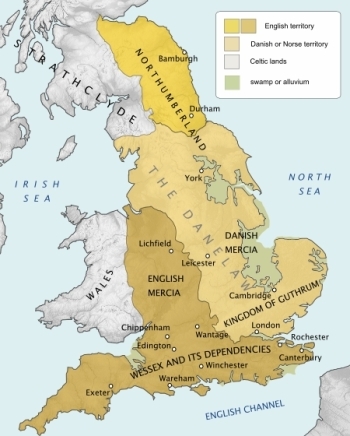
However, there were other areas of England classed as swamp or alluviam see map of 878 AD on left. There is an important literary occurrence of the name in the early epic tale of Beowulf written in Old English with the action taking place in Denmark. In Beowulf the lair of the dragon was called fenhopu and also morhupo. Fen is self explanatory and mor must be short for moor - muir in Scotland. These words in Beowulf have been translated as marsh retreats. Moor(e) and Muir have become surnames in their own right.
Regarding 1) and 2) above - these will probably not apply to the Scottish Highlands/Islands nor to Ireland as the word hope was not absorbed into the local nomenclature here as it was in other areas. Definition 3) however could apply to both areas. There is a possible very interesting heraldic reference in Ireland that could be a source of the name in Ireland - see section 7 Irish Hopes page.
Each of the areas involved also have distinctive heraldry - see armorials at head of page and also Section 9 -Hope Family Heraldry. These armorials give little indication of any commonality that would show some connection between the different Hope families except for the intriguing heraldic device of Chough/Raven highlighted on the Hope Family Heraldry page on the section for North Wales. It is also of note, as high lighted on the Heraldry page, that Scottish Border surnames that include hope as part of the surname viz Hopkirk, Pringle (Hopringle), Soonhope etc - that are habitational names - also have very little commonality in their heraldry.
The concept of there being many strands of the origin of the surname based on the evidence above is considerably enhanced by the appearance of the name appearing for the first time in the records at diverse locations and in the case of the Edinburgh Hope family at a different time. Habitational Hope surnames are included as interestingly they would appear to have been recorded earlier than the Hope surname and also because some of these Habitational Hope surnames were subsequently shortened to just Hope.
Scottish Borders - W de Lindesein de Fauhope in the reign of Malcolm IV, King of Scots (1153-1165) and Elena de Morville de Harhope in the reign of William, King of Scots (1165-1214). John Hope of Peeblesshire 1296.
Northumbria England - Robert of Gresshope at Kershope Castle in the reign of Malcolm IV, King of Scots (1153-1165). Walter and Richard Stanhope 1338 in Durham.
Ireland - William Hope of Hopestown, Mullingar. Westmeath 1214.
Central England - Lady Mariota Hope of Hope, Derbyshire, b1220. Married to Sir William Eyre (1223-1299) of Hope ,Derbyshire. Also Roger de la Hope, Hereford Hundred Rolls, 1273, and Richard de Hope, Salop Shropshire, Hundred Rolls 1273.
North Wales - Hugh Hope of Hawarden, Flintshire, Wales 1297.
Edinburgh Scotland - Thomas Hope 1470 and John Hope c1472.
The topographical feature of a hope as a narrow valley can be found in various densities over the UK but the hopes found in the Scottish Border area are very distinctive because of their ancient glacial origins. Many of these valleys were named resulting in some becoming surnames in their own right and classed as habitational names.
Hope as a location is first recorded in Derbyshire in England in a charter of 926 AD by King Athelstan. Although the charter is in Latin the word Hope is spelt as it is today. This area in Derbyshire could be one of the many cradles of the origin of the surname - a village of the name still exists in the picturesque Hope Valley - see below. See also the Derbyshire entry on page 5. English Hope Families where it suggests that the origin of Hope here maybe Danish! 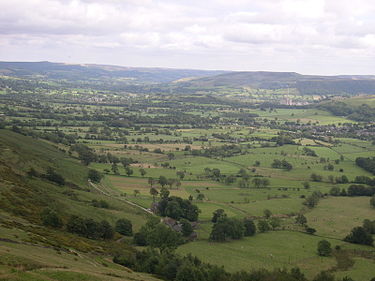
This website started off as principally concerned with the Scottish Hope family, in particular the Scottish Border Hopes. However it soon came clear that the Scottish Hopes comprise only part of the total number of UK/Ireland Hopes. Information on all areas available from the comprehensive menu below.
The concept of many strands of the origin of the surname as evidenced by the heraldry and the early records discussed above is further greatly enhanced by the results of the Ancestral DNA testing of males with the surname of Hope. This reveals the diverse discrete nature of the origins of the name as it is found to be spread over the major DNA Haplogroups found in the UK namely R1,I and E and many of those with no matches found. Some Hope surnames may have been shortened from the Habitational Hope surnames. ie Hopringle altered to two names Hope and Pringle. If you would like to know more about Ancestral DNA and its application to the surname of Hope I suggest a visit to the Clan Hope Society website. The Society is based in the US and can be found at www.clanhope.org - go to the DNA Project on the menu bar - click on Hope DNA Surname page then on Y-DNA results. There is also now a clan Hope Society in Australia (2015) and they can be found at www.clanhopeaustralia.org.
The female first name of Hope has its origins in the Bible - 1 Corinthians 13:12 13:13 and 14:1 - Hope, Faith & Charity (Love). It should be noted that both Faith and Love are surnames so why not Hope?
Again from the 60 volume Oxford English Dictionary that defines this form of hope - hope,n1 - Expectation of something desired; desire combined with expectation. I like the word Esperance to cover this definition of hope.
It is possible that a small group of the Surname of Hope has its origin in Esperance. The Hope family of Edinburgh with its probable origins in Holland/Flanders could have its name derived from Hoop the Dutch for Esperance, does come to mind. See the Hope Family Heraldry page where the canting heraldry of the Hope family includes the following references to Esperance :- a) in their motto - At spes, b) their crest - a rainbow and c) the supporters - ladies dressed in green holding anchors - both the colour of green and anchors are emblems of esperance.
The surname profiling chart shown further on shows that the surname of Hope can be mainly found in the Border area of Scotland, Northumbria /Durham and northern Cumbria in England and in the Lancashire/Cheshire area with a minor concentration in the south-east of England. In Scotland/Northumbria a hope is a topographical feature of an enclosed upland valley. These valleys were named with hope either as a prefix or a suffix and it is this form that it first appears in the Scottish records in the twelfth century in Border charters usually as a location or as a boundary marker. - more about boundary markers below. These valley names were incorporated into personal names viz. Ada de Waleuhope and Elena de Morville de Harhope in the reign of William, King of Scots (1165-1214). The name Hope by itself first appears in the Scottish records in 1296.
The following re-oriented and updated chart shows how I believe the ancestors of the Hopes came to Britain/Ireland and how the name dispersed. The chart indicates that the Angles/Danes (Vikings) arrived c700 on the East coast of Britain - the Angles of course gave England its name - this indeed was the time that a large number of invaders from the continent did arrive on the eastern seaboard of Britain but there had been immigrants arriving over the previous three millenia. An important group of these early immigrants were the Beaker People who it now believed brought the R1b DNA Haplogroup to the UK - later arrivals would also have this Haplogroup. Also shown on the chart is the arrival of the Vikings (Norsemen) to Dumfries & Galloway in the south west of Scotland and on to Cumbria in England, North Wales and also to Ireland via the Isle of Man. What is not shown is that these Norsemen also entered the Clyde estuary and sacked Dumbarton Castle the seat of the Kings of Strathclyde. What is also not shown is that there was a secondary invasion across the Irish Sea from Norsemen settled in Dublin and Waterford. The early Norsemen were based in the Northern Isles - Shetland and Orkney and also in the Western Isles - the Inner and Outer Hebrides. If you believe that your ancestors came from Scotland or Cumbria and your DNA is I-S142 or R1a-S443 then you are without doubt of Scandinavian origin. The chart shows the general drift of peoples but there would also have been much to and fro movement.
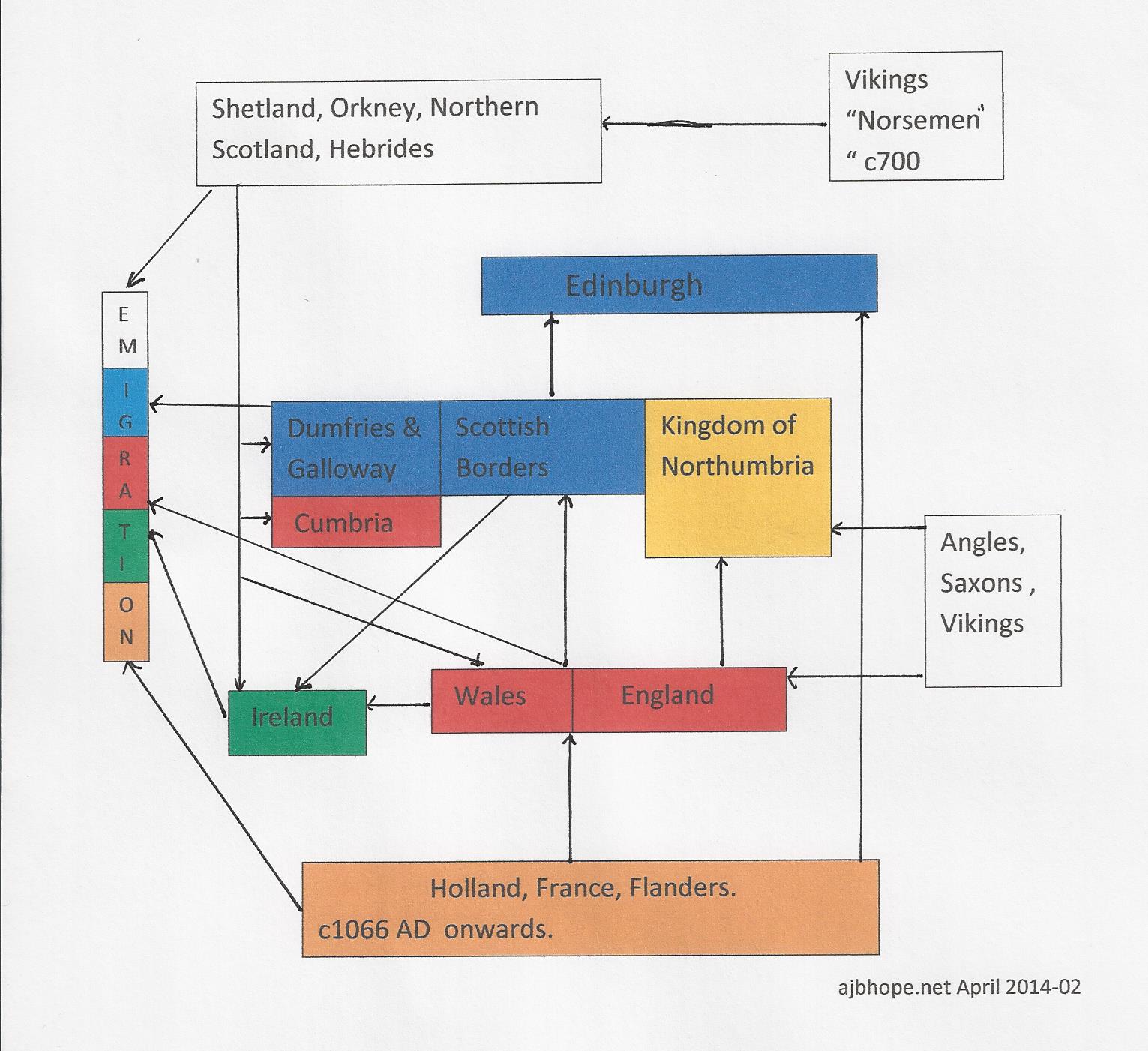
I have divided my research into twelve sections which can be accessed individually from the Contents List on this page. At the end of each section there is an option to continue to the next section directly or return to this page and select another section.
Contents. Click on section below.
1) Not in use.
2.1) Scottish Border Hope Families - Part one - before 1296 AD
2.1.1) Connection with the Kingdom of Northumbria
2.1.2) Liber Sancte Marie de Melros and Liber de Kelso. Hope associated names including earliest examples.
2.2) Scottish Border Hope Families - Part 2 - after 1296 AD
2.2.1) Ragman Roll - Hope and associated names.
2.2.2) Calendar of Close Rolls for Tynedale. Many hope valley names.
2.2.3) Register of the Burgh of Peebles. Hope locations and Surnames.
2.3) Scottish Highlands and Islands.
3) Edinburgh (Scotland) Hope Family. Merchants, Craighall Clan Chief, Hopetoun etc.
3.1) Edinburgh Burgess Rolls - Extract - 1406-1700. - Hope name.
3.2) Edinburgh Apprentice Rolls - Extract. - Hope name.
3.4. Granton Castle.
4) Amsterdam/Rotterdam Hope Families T. M Devine in his book Scotland's Empire The Origins of The Global Diaspora wrote that "Henry Hope a scion of the Hope family of Craighall, had settled in Amsterdam in the early 1600s and there laid the foundations of a great fortune. By the eighteenth century the Hopes were arguably the most prominent bankers in the Netherlands."
During the research of the Hope Families of Scotland other Hope families from elsewhere were considered - see sections 5-7 below and these sections are being expanded. At the moment no connection can be found to link them to the Scottish Hope families apart from a Hope family in Lancashire - however there is an intriguing heraldic connection between the Hope families of Derbyshire and North Wales - see Section 9 on heraldry below.
5. England Hope Families - Origin of name has possible connections with waste land caused by lead mining. Also in the South East a connection with marshes.
6. North Wales Hope Families- Hope of Broughton. Mouats, Flintshire.
7) Ireland Hope Families. - Westmeath, Ulster.
8) Hope Early Colonial Settlers.- America, Jamaica, Barbados - including Hopes on the freed slaves register.
9) Hope Family Heraldry.- Scottish, English, Welsh, Irish and Dutch.
References/Bibliography for Surname Hope
Surname Profiling Chart.
Interesting maps showing the spread of the surname in the UK can be found at the Surname Profiling site operated by UCL www.gbnames.publicprofiler.org. First go to the Great Britain Family Name Profiler page and find the Search Box. A copy of map from this site - with site permission - is below and shows the name principally straddling the Scottish/English Border, Dumfries & Galloway, the Lothians, and also in Northumbria and Cumbria.
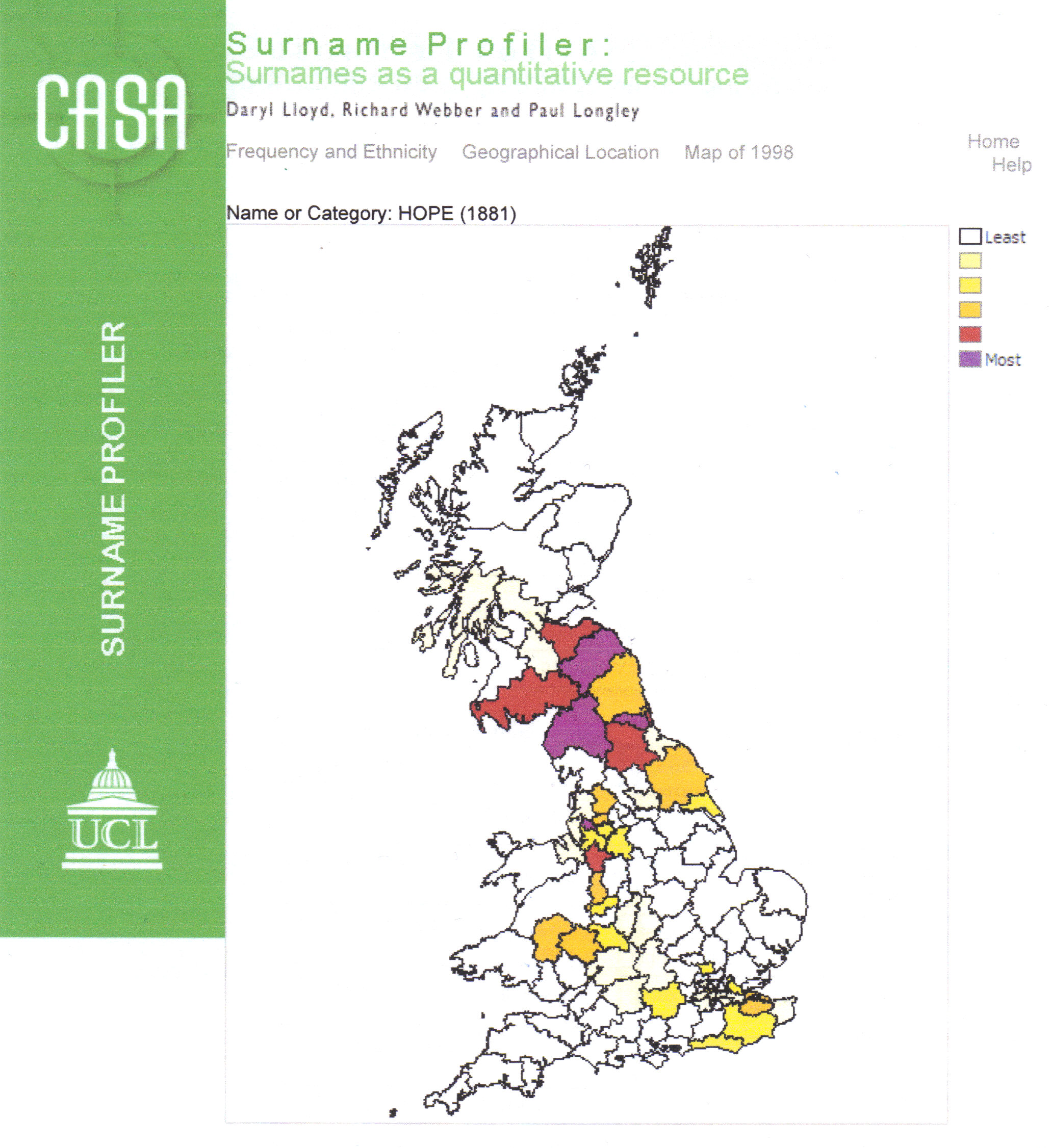
Further Miscellaneous research work.
The Hopes in Scotland can be divided into two separate groups although this may seem a bit simplistic I do believe that there was a core of Hopes in Edinburgh (Edinburgh Hopes) and a core of Hopes in the Scottish Borders (Scottish Border Hopes) that had on the face of it very little commonality apart from their name. The name that possibly came from totally different derivations and appearing for the first time in the Scottish records at different times - recent DNA evidence points to the fact that there is indeed no direct connection between the Edinburgh Hopes and the Border Hopes - also some of the various Border Hope families may not be related to each other. Family trees of some of these Border Hopes can be found on the Other Border Hopes page. What I call the Edinburgh Hopes were just that. What I refer to as the Scottish Borders Hopes were found in an area including Northumbria and Durham, particulary the North Tyne area in the Keilder area also Cumbria north of The River Tyne in present day England, and also the River Tweed Valley and its tributaries and also northwards into the Lothians to include the Lammermuir and Moorfoot Hills area in Scotland ie as far north as the south of Edinburgh. The Border Hopes were first recorded in 1296 in the era now known as the First War of Independence but they would have been in the area long before this and were probably involved in the wool trade that was managed by the Cistercian Monks of Melrose. While the Edinburgh Hopes evolved from a background of merchant/banking stock in the 14th/15th centuries. The two groups gradually merged into one armigerous Scottish family with a Clan Chief - the Clan Chief being descended from the senior line of Craighall of the Edinburgh Hopes and has been ratified by the Court of the Lord Lyon. In theory the Clan Chief is only chief of those of Scottish descent.
Recent research - December 2013 - indicates that there may be a third small group of Hopes centred on Leadhills in South Lanarkshire. This research is in connection with the possibility that the origin of the surname of Hope in Derbyshire in England may have connection with waste land caused by old lead/silver mines. See the Derbyshire section of the English Hopes page. Up to now the Hopes from South Lanarkshire have been grouped with the Border Hopes.
A topographical feature such as a hope as an enclosed valley was important as a boundary marker. An inspection of boundaries, particulalry of common land to prevent encroachment from neighbouring landlords, was routine. The following from the Peebles records - The marches of Hamilton Hill were periodically visited by the town council and community. An account of one of these perambulations, on 7th June 1556 appears in the printed Records, and is described as a visitation, in accustomed form, of the marches between the lands of Kidstoun, Chapelhill, and Eddistoun, and the property of Hammiltoun belonging and pertaining to the baillies, community, and inhabitants. Begining at places called Burrelfield and Acomfield, (now Rosetta and neighbourhood), the march went up the syke to Jedburghfield, over the swyre and on to the syke in Eddistoun hoip, which it passed upwards, thence to Kidstoun hoip heid, which it passed downwards, and thence eastwards, north, and south-eastward, by march stones, cairns, bushes, and other land marks, till the starting point was regained. What is interesting is the number of topographical features that have become Scottish Surnames - March, Swyre (Swire), Syke (Sykes), Hoip (Hope), hope heid (Hopehead), Stone, Cairns and Bush! The custom of inspecting the boundaries is carried on to this day in the form of the Riding the Marches in several Scottish Border towns.
A list of the names of various scottish valley and waterway names in order of magnitude follow:-
Valleys - Cleuch, Hope, Glen, Valley and Dale. (Cleuchs & Hopes are closed at one end)
Waterways - Syke, Burn, Water, River and Firth(Estuary).
It is worth mentioning that the word Hope as a topographical feature would have arrived in Scotland from England in the Anglo-Saxon period (c400-900) long before the advent if surnames in Scotland c1100. The feature that the residents of the Border area named a hope probably bore very little resemblance to the Anglo-Saxon feature of a hope in England.
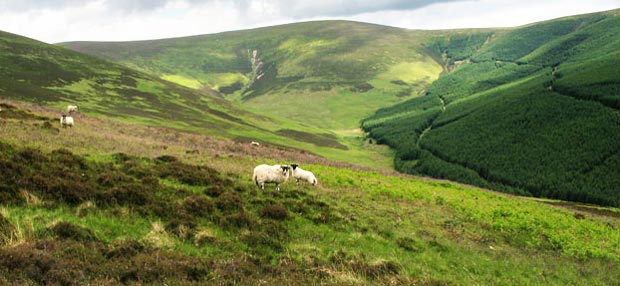
The head of Hopecarton in Peeblesshire showing the enclosed end. The hope is very narrow with a burn (stream) running through it providing watering facilities for the sheep. The hope widens as it merges with the valley of the River Tweed. There are comparatively few sheep now compared to the numbers that would have grazed over these hills when the monks of Melrose managed this area in the thirteenth/fourteenth century.
On the north coast of Scotland there is an area that was known as Hope that includes Loch and Ben Hope and the emonymous hamlet. A derivation from this area is possible as the Norse influence did spread southwards along the west coast as far as the Solway, the Isle of Man, Cumbria and Ireland. The influence also spread inland in Scotland through Ayrhire to Lanarkshire. The surname of Obrinkle appearing in the Ragman's Roll is interesting - See Section 3 Border Hopes. The Ob and Hob representing a haven in Norse does appear as a prefix in place names such as the west coast town of Oban.
The linking of Hope with a haven, either land based or maritime is valid. On the Firth of Forth just west of the bridges is a point known as St. Margaret’s Hope. This is where Margaret Atheling, future Queen of Scots and Saint, stepped ashore with her father Edgar Atheling a saxon claimant to the English throne. They were fleeing England by sea after the Norman invasion of 1066 and were blown off course. They had made a previous landfall in Northumbria and that site is known as St. Margaret’s Haven.
Another example of this, which coincidently is in the same area, is in Kidnapped a novel set in 1751 by Robert Louis Stevenson. “Just then we came to the top of the hill, and looked down on the ferry and the Hope. The Firth of Forth narrows at this point to the width of a good sized river, which makes a convenient ferry going north, and turns the upper reach into a land-locked haven, for all manner of ships.”
Twentieth century literary examples of a hope as an enclosed valley were penned by John Buchan (1875-1940). In his short story the Green Glen his description of the glen mentions the green hope at the head. Buchan also mentions the Border hopes several times in the context of the excellent fly fishing for trout in his his unfinished work about fishing titled Pilgrims Rest.
William Chambers in his History of Peeblesshire published in 1864 had the following to say about Hope - The resemblance between many words in Norwegian, Danish, and old Saxon, renders it difficult to assign a distinct origin to certain names. No affix is more common in Peeblesshire than Hope, as Soonhope, Gaithope, Waddenhope, etc. The meaning of the term is a valley among hills, closed at one end, a cul-de-sac: literally, it denotes a haven or place of refuge (Islandic, Hop), in which sense it is applied to various maritime resorts. Hope was formally used also as a prefix - for example, in Hopkailzie, the old name for Kailsie.
The emblem of a ship’s anchor is an emblem of hope as is the cross for faith and the heart for charity/love. The various Hope families have used the anchor to good effect in their canting heraldry - see section 9 Hope Heraldry. There are several pubs named the Hope & Anchor in England, Wales and overseas in USA, Canada etc but none in Scotland. At least one, in Wirksworth in Derbyshire, has the pub hanging sign showing the Hope lady with the anchor - see below.
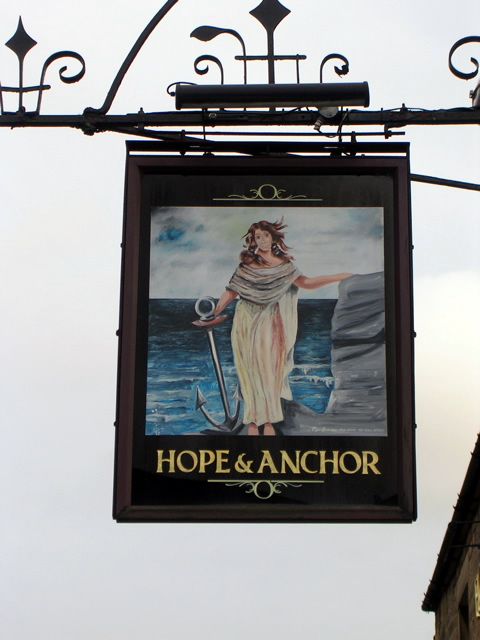
At dysart in Fife there is the following ancient inscription above a doorway My hoip is in the Lord 1583. Whether the inscription is that old is doubtful. Hoip was a recognised spelling of hope.
What unbalances the Hope name in Scotland is one particular family, namely the descendants of Sir Thomas Hope of Craighall Bt. (1573-1646) – Lord Advocate to Charles I. This family over the centuries has added a lustre to the name resulting in the Scottish Hopes punching well above their weight. A dramatic example of this is that in 1995 in the House of Lords there were seven peers with the surname of Hope. This is a record number of peers with the same surname being members of the House of Lords at the same time. Five of the seven peers were Scottish all being descendants of the above Sir Thomas Hope of Craighall! These five peers being Glendevon, Craighead, Linlithgow (Marquis), Rankeilor and Hope-Johnstone (Earl). The other two were English, one was the Rev. David Hope then Bishop of London subsequently Archbishop of York now Lord Hope of Thornes, Wakefield, West Yorkshire. The other is Hope-Morley, Baron Hollenden of Hall Place in Kent. It is believed that descendants of Sir Thomas settled in Lancashire - see the Lancashire section of the English Hope page.